Frequency Dependence of the Correlation between Ozone and Temperature Oscillations in the Middle Atmosphere
Abstract
:1. Introduction
2. Dataset and Data Analysis
2.1. Dataset
2.2. Data Analysis
3. Results
3.1. Results around Bern at Mid-Latitudes
3.2. Results at the Equator
4. Conclusions
Author Contributions
Funding
Informed Consent Statement
Data Availability Statement
Acknowledgments
Conflicts of Interest
References
- Chapman, S. The absorption and dissociative or ionizing effect of monochromatic radiation in an atmosphere on a rotating earth. Proc. Phys. Soc. 1931, 43, 26–45. [Google Scholar] [CrossRef]
- Zhou, L.; Xia, Y.; Zhao, C. Influence of Stratospheric Ozone Changes on Stratospheric Temperature Trends in Recent Decades. Remote Sens. 2022, 14, 5364. [Google Scholar] [CrossRef]
- Solomon, S.; Ivy, D.; Gupta, M.; Bandoro, J.; Santer, B.; Fu, Q.; Lin, P.; Garcia, R.R.; Kinnison, D.; Mills, M. Mirrored changes in Antarctic ozone and stratospheric temperature in the late 20th versus early 21st centuries. J. Geophys. Res. Atmos. 2017, 122, 8940–8950. [Google Scholar] [CrossRef]
- Randel, W.J.; Wu, F.; Ming, A.; Hitchcock, P. A simple model of ozone—Temperature coupling in the tropical lower stratosphere. Atmos. Chem. Phys. 2021, 21, 18531–18542. [Google Scholar] [CrossRef]
- Calisesi, Y.; Wernli, H.; Kämpfer, N. Midstratospheric ozone variability over Bern related to planetary wave activity during the winters 1994–1995 to 1998–1999. J. Geophys. Res. 2001, 106, 7903–7916. [Google Scholar] [CrossRef]
- Studer, S.; Hocke, K.; Kämpfer, N. Intraseasonal oscillations of stratospheric ozone above Switzerland. J. Atmos. Sol.-Terr. Phys. 2012, 74, 189–198. [Google Scholar] [CrossRef]
- Hocke, K.; Studer, S.; Martius, O.; Scheiben, D.; Kämpfer, N. A 20-day period standing oscillation in the northern winter stratosphere. Ann. Geophys. 2013, 31, 755–764. [Google Scholar] [CrossRef]
- Flury, T.; Hocke, K.; Haefele, A.; Kämpfer, N.; Lehmann, R. Ozone depletion, water vapor increase, and PSC generation at midlatitudes by the 2008 major stratospheric warming. J. Geophys. Res. 2009, 114, 18302. [Google Scholar] [CrossRef]
- Baldwin, M.P.; Ayarzagüena, B.; Birner, T.; Butchart, N.; Butler, A.H.; Charlton-Perez, A.J.; Domeisen, D.I.V.; Garfinkel, C.I.; Garny, H.; Gerber, E.P.; et al. Sudden Stratospheric Warmings. Rev. Geophys. 2021, 59, e2020RG000708. [Google Scholar] [CrossRef]
- Butler, A.H.; Sjoberg, J.P.; Seidel, D.J.; Rosenlof, K.H. A sudden stratospheric warming compendium. Earth Syst. Sci. Data 2017, 9, 63–76. [Google Scholar] [CrossRef]
- Hocke, K.; Lainer, M.; Schanz, A. Composite analysis of a major sudden stratospheric warming. Ann. Geophys. 2015, 33, 783–788. [Google Scholar] [CrossRef]
- Prather, M.J. Ozone in the upper stratosphere and mesosphere. J. Geophys. Res. Ocean. 1981, 86, 5325–5338. [Google Scholar] [CrossRef]
- Brasseur, G.P.; Solomon, S. Aeronomy of the Middle Atmosphere: Chemistry and Physics of the Stratosphere and Mesosphere, 3rd ed.; Springer: Dordrecht, The Netherlands, 2005; p. 644. [Google Scholar]
- Schanz, A.; Hocke, K.; Kämpfer, N. Daily ozone cycle in the stratosphere: Global, regional and seasonal behaviour modelled with the Whole Atmosphere Community Climate Model. Atmos. Chem. Phys. 2014, 14, 7645–7663. [Google Scholar] [CrossRef]
- Craig, R.A.; Ohring, G. The temperature dependence of ozone radiational heating rates in the vicinity of the mesopeak. J. Atmos. Sci. 1958, 15, 59–62. [Google Scholar] [CrossRef]
- Pisoft, P.; Sacha, P.; Polvani, L.M.; Añel, J.A.; de la Torre, L.; Eichinger, R.; Foelsche, U.; Huszar, P.; Jacobi, C.; Karlicky, J.; et al. Stratospheric contraction caused by increasing greenhouse gases. Environ. Res. Lett. 2021, 16, 064038. [Google Scholar] [CrossRef]
- World Meteorological Organization. Scientific Assessment of Ozone Depletion: 2022; GAW Report No. 278; WMO: Geneva, Switzerland, 2022; p. 509.
- Stolarski, R.S.; Douglass, A.R.; Remsberg, E.E.; Livesey, N.J.; Gille, J.C. Ozone temperature correlations in the upper stratosphere as a measure of chlorine content. J. Geophys. Res. Atmos. 2012, 117, D10305. [Google Scholar] [CrossRef]
- Saiz-Lopez, A.; Fernandez, R.P.; Li, Q.; Cuevas, C.A.; Fu, X.; Kinnison, D.E.; Tilmes, S.; Mahajan, A.S.; Gómez Martín, J.C.; Iglesias-Suarez, F.; et al. Natural short-lived halogens exert an indirect cooling effect on climate. Nature 2023, 618, 967–973. [Google Scholar] [CrossRef]
- Lee, J.N.; Wu, D.L. Solar Cycle Modulation of Nighttime Ozone Near the Mesopause as Observed by MLS. Earth Space Sci. 2020, 7, e2019EA001063. [Google Scholar] [CrossRef]
- Garcia, R.R.; Solomon, S. The effect of breaking gravity waves on the dynamics and chemical composition of the mesosphere and lower thermosphere. J. Geophys. Res. Atmos. 1985, 90, 3850–3868. [Google Scholar] [CrossRef]
- Moreira, L.; Hocke, K.; Navas-Guzmán, F.; Eckert, E.; von Clarmann, T.; Kämpfer, N. The natural oscillations in stratospheric ozone observed by the GROMOS microwave radiometer at the NDACC station Bern. Atmos. Chem. Phys. 2016, 16, 10455–10467. [Google Scholar] [CrossRef]
- Fadnavis, S.; Beig, G. Features of SAO in ozone and temperature over tropical stratosphere by wavelet analysis. Int. J. Remote Sens. 2010, 31, 299–311. [Google Scholar] [CrossRef]
- Smith, A.K.; Gray, L.J.; Garcia, R.R. Evidence for the Influence of the Quasi-Biennial Oscillation on the Semiannual Oscillation in the Tropical Middle Atmosphere. J. Atmos. Sci. 2023, 80, 1755–1769. [Google Scholar] [CrossRef]
- Huang, F.T.; Mayr, H.G.; Reber, C.A.; Russell, J.M., III; Mlynczak, M.G.; Mengel, J.G. Ozone quasi-biennial oscillations (QBO), semiannual oscillations (SAO), and correlations with temperature in the mesosphere, lower thermosphere, and stratosphere, based on measurements from SABER on TIMED and MLS on UARS. J. Geophys. Res. Space Phys. 2008, 113, A01316. [Google Scholar] [CrossRef]
- Waters, J.W.; Froidevaux, L.; Harwood, R.S.; Jarnot, R.F.; Pickett, H.M.; Read, W.G.; Siegel, P.H.; Cofield, R.E.; Filipiak, M.J.; Flower, D.A.; et al. The Earth Observing System Microwave Limb Sounder (EOS MLS) on the Aura satellite. IEEE Trans. Geosci. Remote Sens. 2006, 44, 1075–1092. [Google Scholar] [CrossRef]
- Livesey, N.J.; Read, W.G.; Wagner, P.A.; Froidevaux, L.; Santee, M.L.; Schwartz, M.J.; Lambert, A.; Valle, L.F.M.; Pumphrey, H.C.; Manney, G.L.; et al. Earth Observing System (EOS) Aura Microwave Limb Sounder (MLS) Version 5.0x Level 2 and 3 Data Quality and Description Document. Technical Report. 2022. Available online: https://mls.jpl.nasa.gov/eos-aura-mls/data-documentation (accessed on 1 July 2023).
- Schwartz, M.J.; Lambert, A.; Manney, G.L.; Read, W.G.; Livesey, N.J.; Froidevaux, L.; Ao, C.O.; Bernath, P.F.; Boone, C.D.; Cofield, R.E.; et al. Validation of the Aura Microwave Limb Sounder temperature and geopotential height measurements. J. Geophys. Res. Atmos. 2008, 113, D15S11. [Google Scholar] [CrossRef]
- Scheiben, D.; Straub, C.; Hocke, K.; Forkman, P.; Kämpfer, N. Observations of middle atmospheric H2O and O3 during the 2010 major sudden stratospheric warming by a network of microwave radiometers. Atmos. Chem. Phys. 2012, 12, 7753–7765. [Google Scholar] [CrossRef]
- Lainer, M.; Kämpfer, N.; Tschanz, B.; Nedoluha, G.E.; Ka, S.; Oh, J.J. Trajectory mapping of middle atmospheric water vapor by a mini network of NDACC instruments. Atmos. Chem. Phys. 2015, 15, 9711–9730. [Google Scholar] [CrossRef]
- Wang, S.; Polvani, L.M. Double tropopause formation in idealized baroclinic life cycles: The key role of an initial tropopause inversion layer. J. Geophys. Res. Atmos. 2011, 116, D05108. [Google Scholar] [CrossRef]
- Bernet, L.; von Clarmann, T.; Godin-Beekmann, S.; Ancellet, G.; Maillard Barras, E.; Stübi, R.; Steinbrecht, W.; Kämpfer, N.; Hocke, K. Ground-based ozone profiles over central Europe: Incorporating anomalous observations into the analysis of stratospheric ozone trends. Atmos. Chem. Phys. 2019, 19, 4289–4309. [Google Scholar] [CrossRef]
- Navas-Guzmán, F.; Kämpfer, N.; Schranz, F.; Steinbrecht, W.; Haefele, A. Intercomparison of stratospheric temperature profiles from a ground-based microwave radiometer with other techniques. Atmos. Chem. Phys. 2017, 17, 14085–14104. [Google Scholar] [CrossRef]
- Krochin, W.; Stober, G.; Murk, A. Development of a Polarimetric 50-GHz Spectrometer for Temperature Sounding in the Middle Atmosphere. IEEE J. Sel. Top. Appl. Earth Obs. Remote Sens. 2022, 15, 5644–5651. [Google Scholar] [CrossRef]
- Miyazaki, K.; Iwasaki, T.; Shibata, K.; Deushi, M. Roles of transport in the seasonal variation of the total ozone amount. J. Geophys. Res. Atmos. 2005, 110, D18309. [Google Scholar] [CrossRef]
- Smith, A.K.; Marsh, D.R.; Mlynczak, M.G.; Mast, J.C. Temporal variations of atomic oxygen in the upper mesosphere from SABER. J. Geophys. Res. Atmos. 2010, 115, D18309. [Google Scholar] [CrossRef]
- Mlynczak, M.G.; Hunt, L.A.; Mast, J.C.; Thomas Marshall, B.; Russell, J.M., III; Smith, A.K.; Siskind, D.E.; Yee, J.H.; Mertens, C.J.; Javier Martin-Torres, F.; et al. Atomic oxygen in the mesosphere and lower thermosphere derived from SABER: Algorithm theoretical basis and measurement uncertainty. J. Geophys. Res. Atmos. 2013, 118, 5724–5735. [Google Scholar] [CrossRef]
- Huang, F.T.; Mayr, H.G. Ozone and temperature decadal solar-cycle responses, and their relation to diurnal variations in the stratosphere, mesosphere, and lower thermosphere, based on measurements from SABER on TIMED. Ann. Geophys. 2019, 37, 471–485. [Google Scholar] [CrossRef]
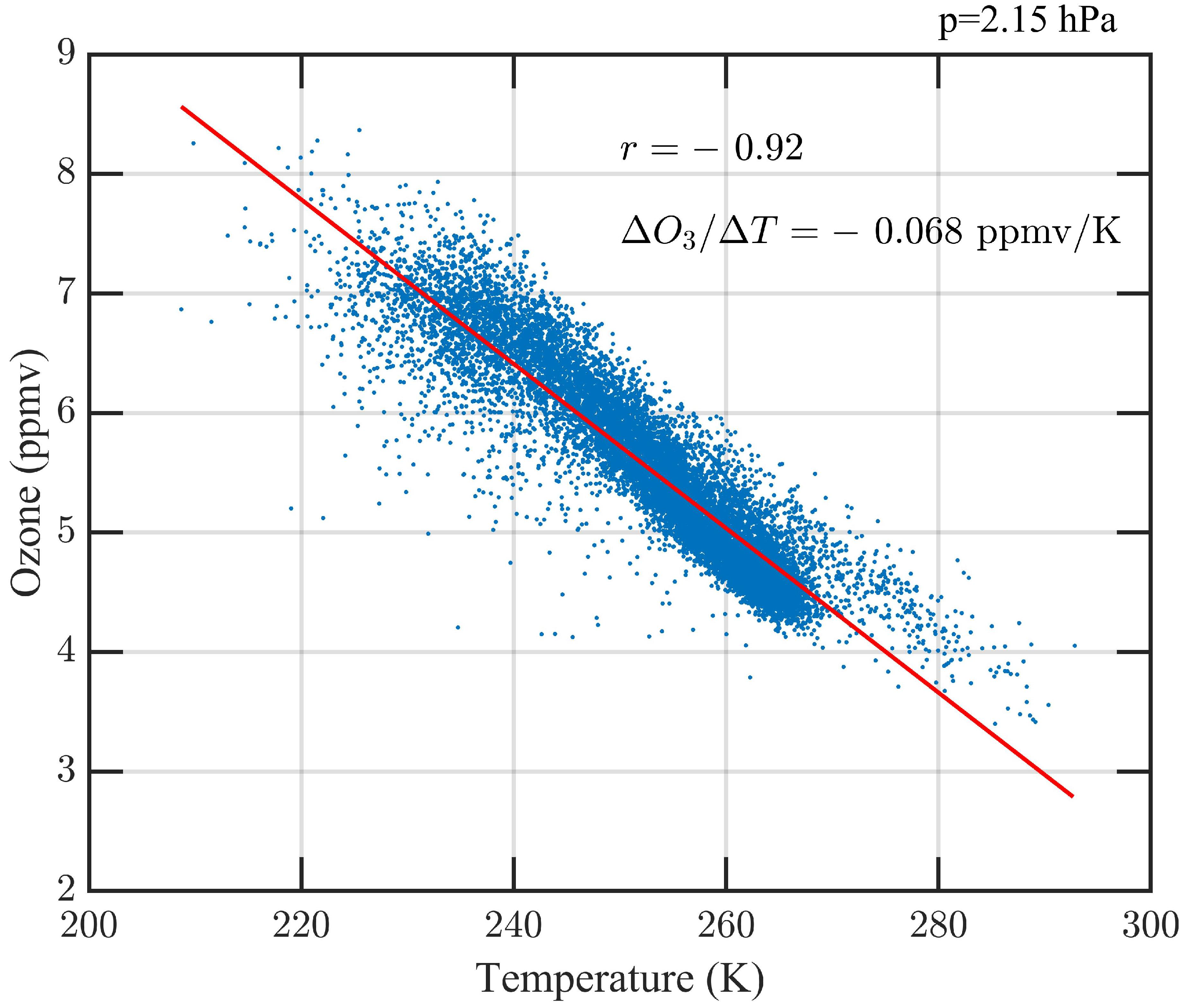

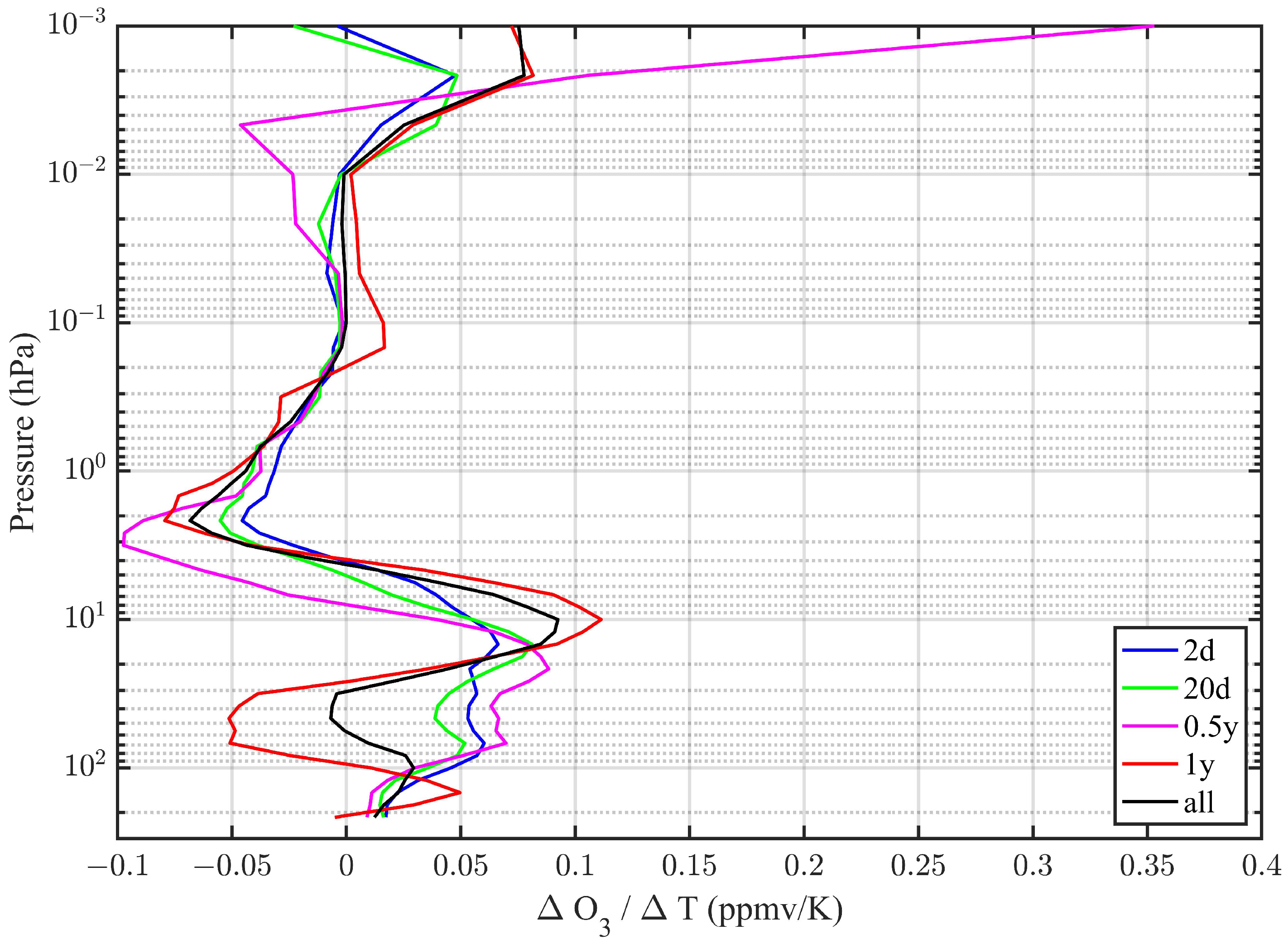
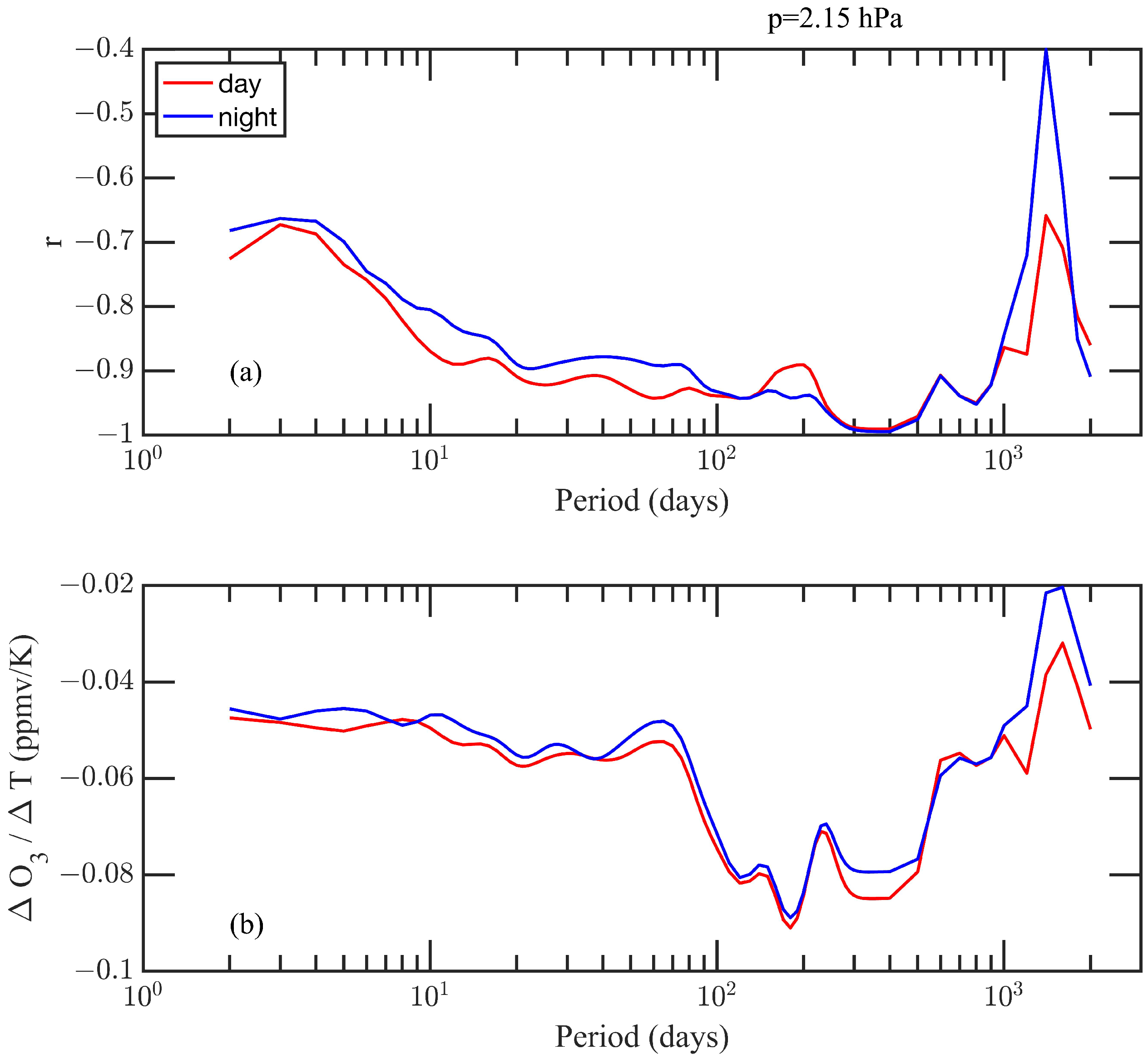
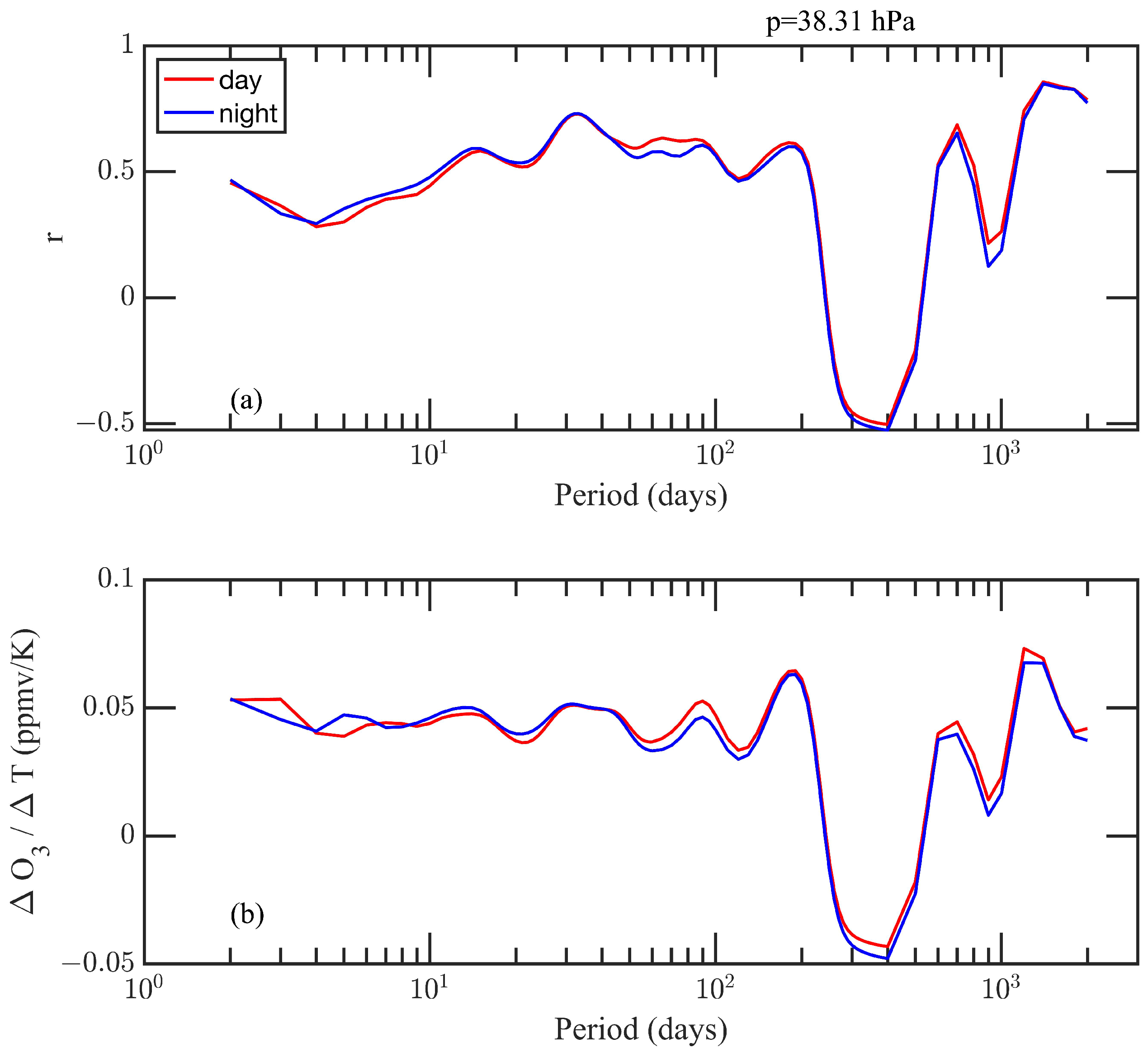
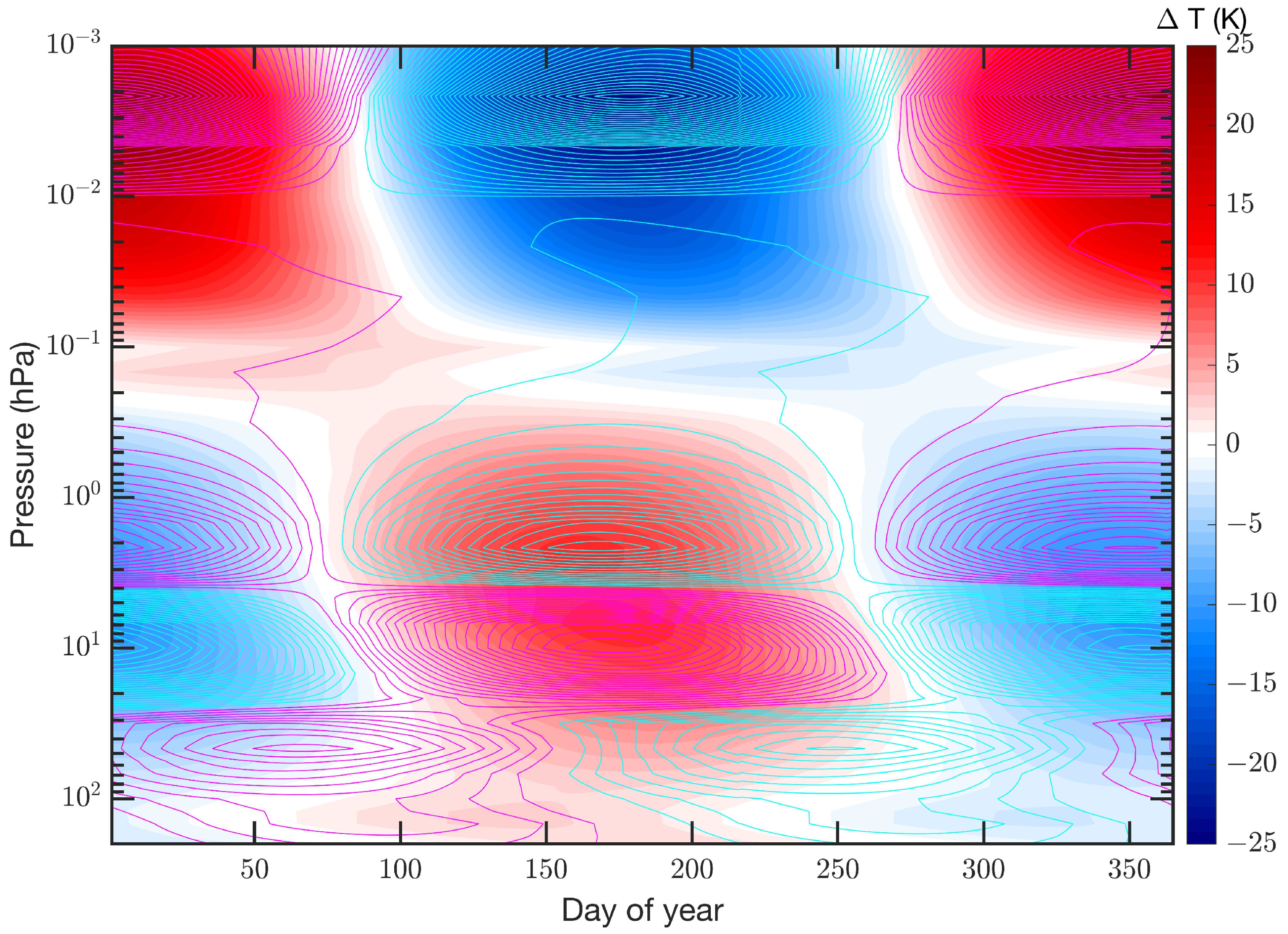
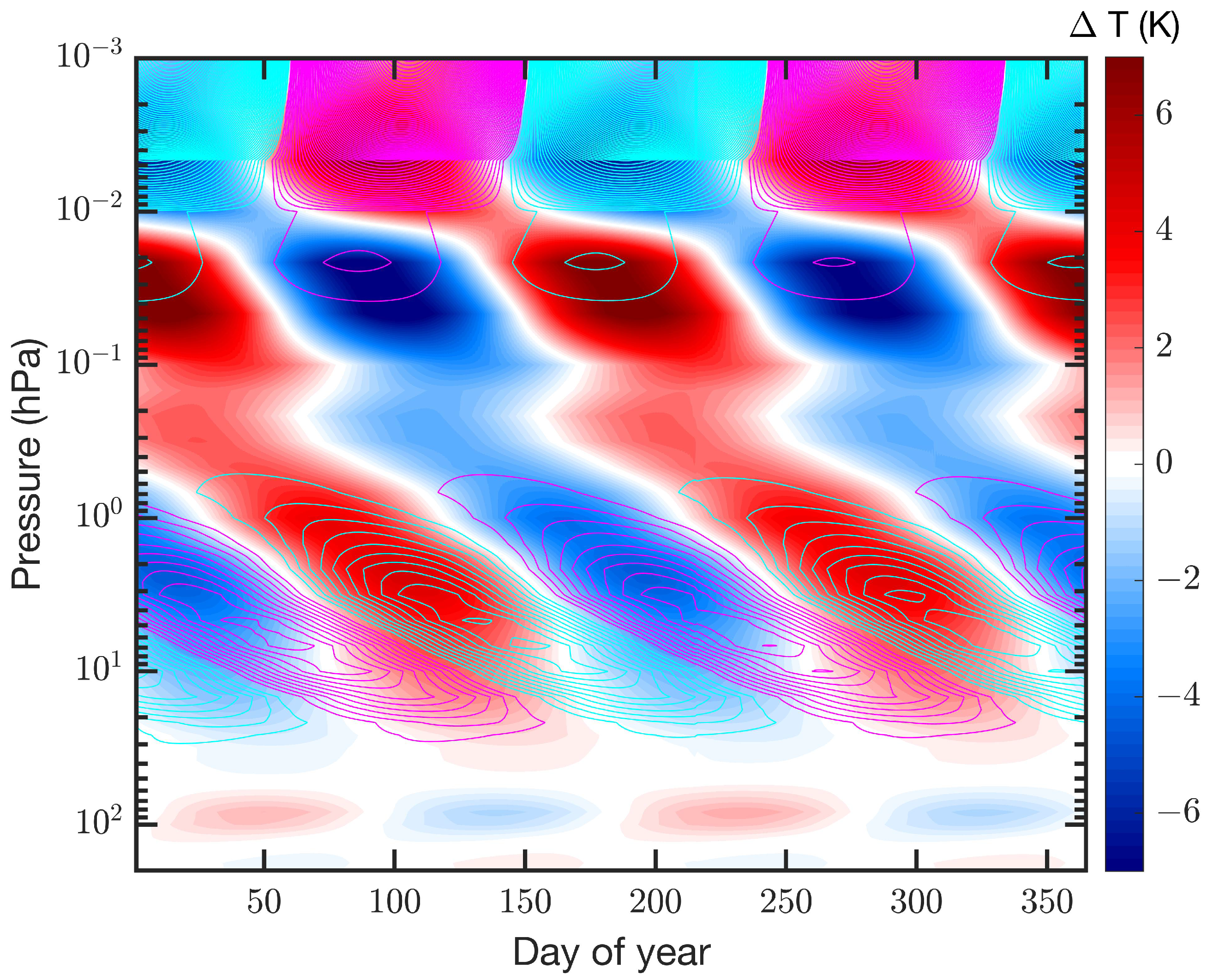
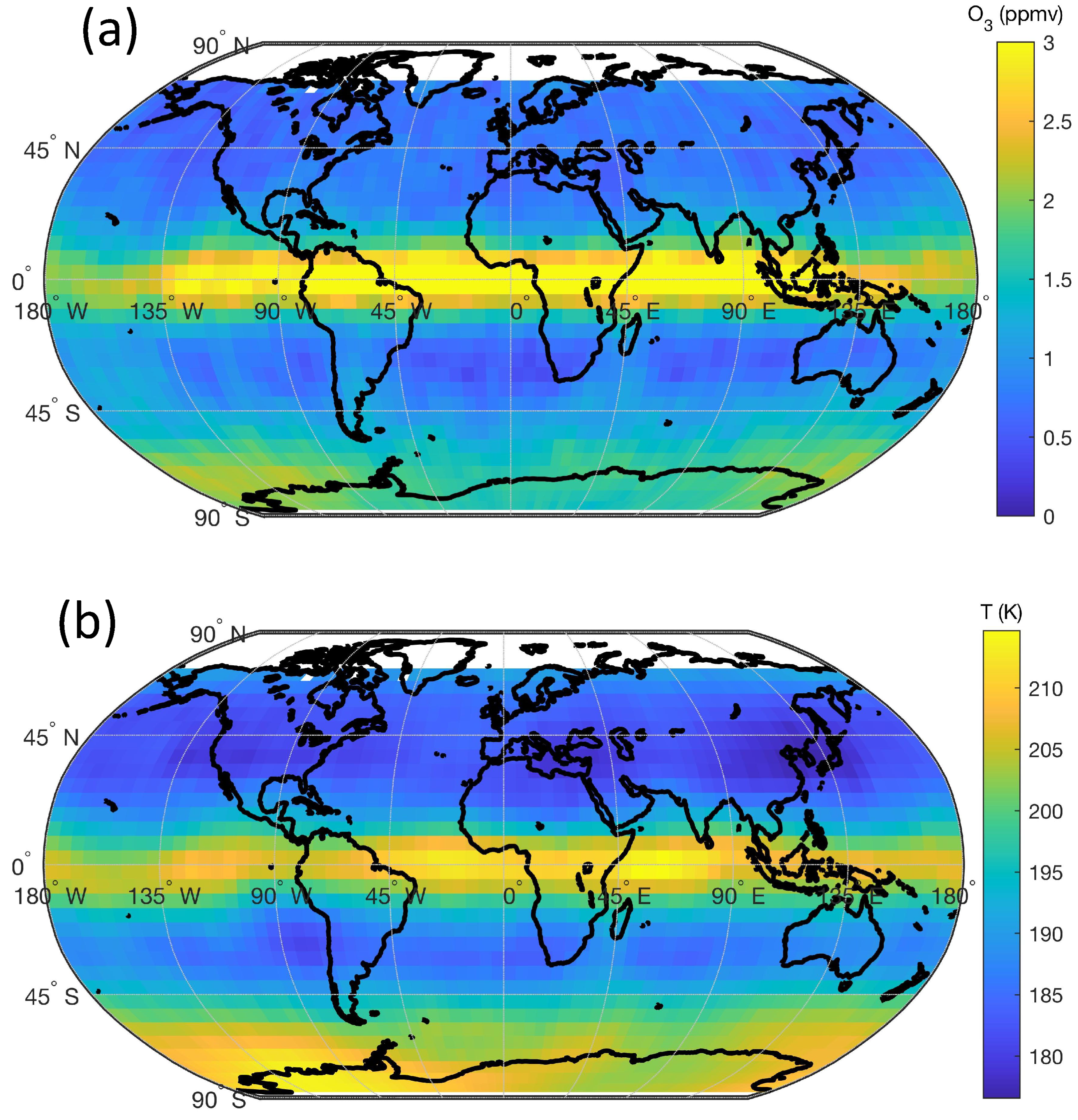

Disclaimer/Publisher’s Note: The statements, opinions and data contained in all publications are solely those of the individual author(s) and contributor(s) and not of MDPI and/or the editor(s). MDPI and/or the editor(s) disclaim responsibility for any injury to people or property resulting from any ideas, methods, instructions or products referred to in the content. |
© 2023 by the authors. Licensee MDPI, Basel, Switzerland. This article is an open access article distributed under the terms and conditions of the Creative Commons Attribution (CC BY) license (https://creativecommons.org/licenses/by/4.0/).
Share and Cite
Hocke, K.; Sauvageat, E. Frequency Dependence of the Correlation between Ozone and Temperature Oscillations in the Middle Atmosphere. Atmosphere 2023, 14, 1436. https://doi.org/10.3390/atmos14091436
Hocke K, Sauvageat E. Frequency Dependence of the Correlation between Ozone and Temperature Oscillations in the Middle Atmosphere. Atmosphere. 2023; 14(9):1436. https://doi.org/10.3390/atmos14091436
Chicago/Turabian StyleHocke, Klemens, and Eric Sauvageat. 2023. "Frequency Dependence of the Correlation between Ozone and Temperature Oscillations in the Middle Atmosphere" Atmosphere 14, no. 9: 1436. https://doi.org/10.3390/atmos14091436
APA StyleHocke, K., & Sauvageat, E. (2023). Frequency Dependence of the Correlation between Ozone and Temperature Oscillations in the Middle Atmosphere. Atmosphere, 14(9), 1436. https://doi.org/10.3390/atmos14091436








